Concrete fence: advantages and disadvantages
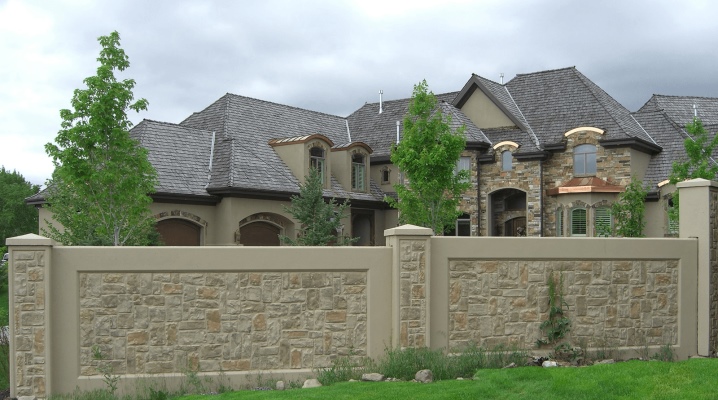
Before choosing a material for a future fence, you need to think about how long it can ideally serve you. The most durable fences are made of stone, brick or concrete. Concrete fences guarantee exceptional strength and low cost in comparison with brick or stone products.
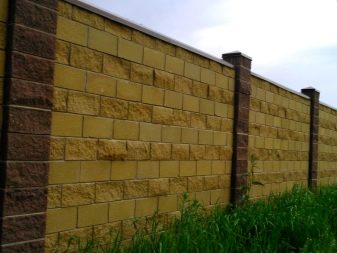
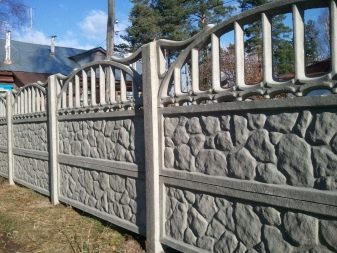
Peculiarities
Concrete fences are known for their long service life and ease of maintenance. The installation of some types of such fences can be done with your own hands. Nowadays, most of the reinforced concrete fences for private cottages are structures with an openwork texture or imitating wood, stylish stones. All reinforced concrete fences are built according to the usual scheme: the steel frame is poured with the most durable concrete, which contains all kinds of plasticizers. The main positive features of such fences are:
- Reliability and long service life. Concrete is the most durable and versatile material.
- Ease of installation. The installation of concrete blocks can, in fact, be done by any man in the street.
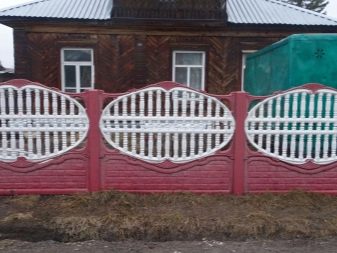
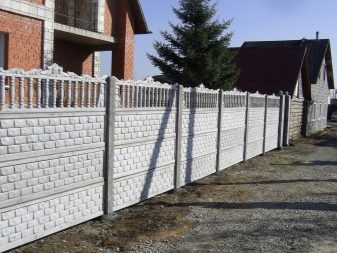
- A variety of original solutions. Despite its massiveness, a concrete fence can look sophisticated. Such a "wall" will decorate the personal plot.
- The appearance of concrete is perfectly combined with other materials: plastic, metal elements, stone.
- All kinds of installation and cladding options. This fence can be combined with any type of gate.
- Minimum financial and labor costs for installation.
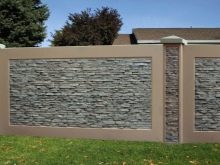
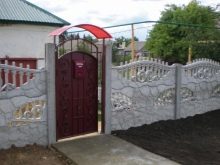
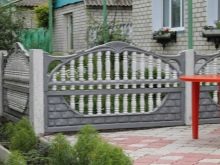
- The ability to install a concrete fence with your own hands, even without certain skills.
- Installation can be carried out without special equipment.
- Ease of coverage renewal and repair.
- Stable position on the ground.
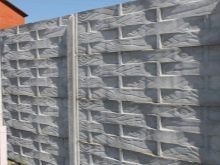
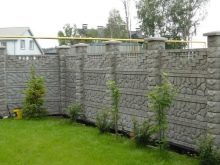
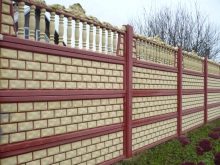
It is worth considering and disadvantages of a concrete fence structure:
- duration of installation work.
- Possibility of installation in warm seasons only.
- The need for accurate calculations.
- When choosing panels for decorating a fence, one should take into account their high price.
- The shading of some areas in the presence of such a continuous fence.
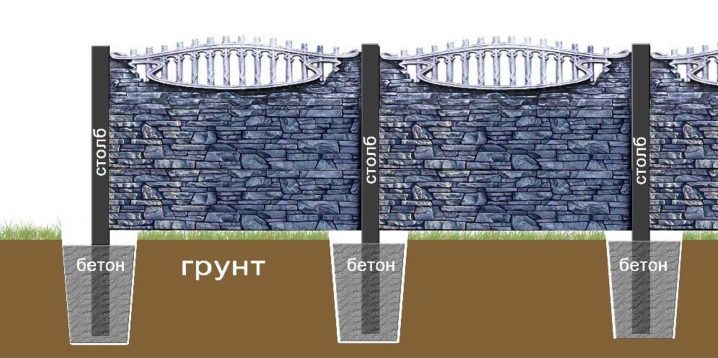
Views
Concrete fences come in several varieties.
Fence type-setting
It looks like a section, which was assembled from 2-4 slabs. The top of the fence can be complemented with stylish decor elements. This fence can be blown through if you leave gaps in it among the laid slabs, and completely tight. Due to the oversized parameters and the weight of the sections, these fences are in high demand in the private sector... You just need to insert the sections into the grooves of the support pillars, so 2-3 people can easily cope with the installation of this option.
The coating of such fences imitates other materials. Those who like natural products will definitely like wood-like concrete panels. A hedge with a texture "like a stone" or "like a brick" looks prestigious and solid.
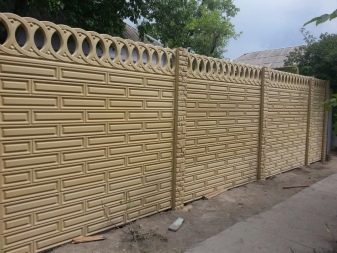
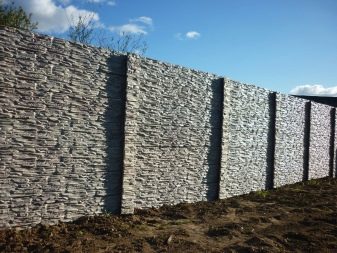
Monolithic product
A monolithic fence is considered the most durable among other types of fences for a reason. The installation technology of this structure requires the mandatory use of a tape or columnar base. The monolithic fence consists of solid slabs of reinforced concrete (completely smooth or with a beautiful pattern).
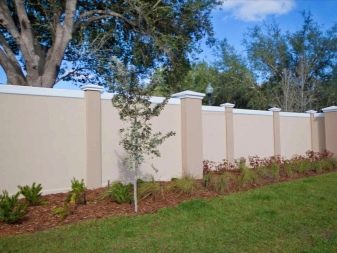
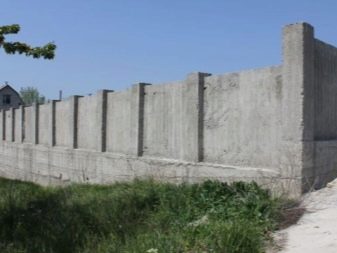
Reinforced concrete fence is the most durable of all, while it has a number of characteristic features.
- Such panels can weigh from half a ton to 4 tons, so special equipment will be needed to fully carry out the installation. In addition, it is already necessary
- This fence will look good only in fairly large areas (fence for a cottage village, construction site, airport).


Smooth structures are most suitable for warehouses and industrial areas, and on areas near the house, slabs with catchy ornaments or painted sections will look harmonious.
Block fence
This type is assembled from small blocks. To hold the elements together, a cement solution is used. Usually, fences of this kind are erected from hollow building materials, but if you want to get the most reliable structure, then you should choose monolithic products. A beautiful view of the prefabricated structure is given using plaster or tiling. Such a product does not need support pillars. In a solid state, it looks more like a high-quality brickwork.
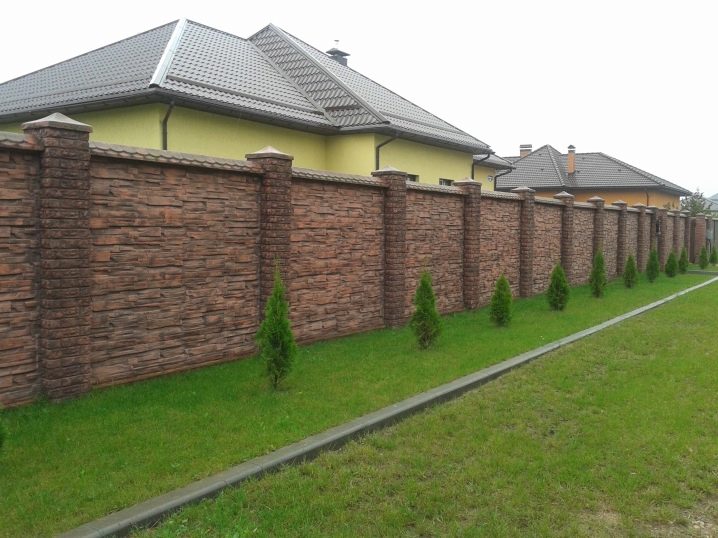
The construction of such a fence takes place quickly enough. The voids inside help to strengthen the structure before pouring it with concrete, in addition, they allow you to place cables inside, for example, for an intercom, which is very convenient. Such fences are installed on the foundation. The main thing is that its width is twice the width of the block itself. This fence is of different heights - it depends on the wishes of the owners of the home.
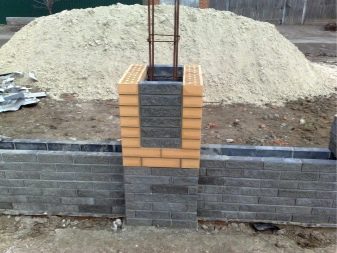
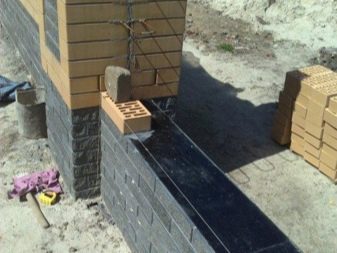
Decorating the blocks will help you build a fence that matches the exterior of your home. The peculiarity of the blocks themselves is that they have a stylish texture from 2 sides at once. The price of this fence will depend, of course, on the parameters and quality of the selected blocks, but it will not be so high, since for 1 sq. m wall is needed only 12, 5 blocks. Exceptional reliability for many years, ease of installation, eye-catching design and affordable cost are the best arguments in favor of choosing this fence.

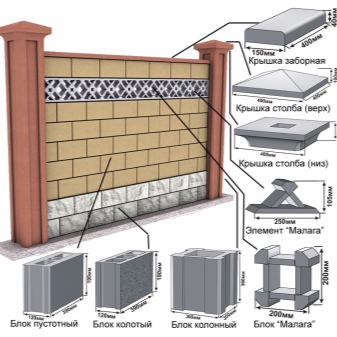
Another significant plus: from the existing elements, you can create a plinth or pillars (for example, in the form of columns of the popular antique style), and you can decorate them with any suitable material: wood, brick, or any of their variations and combinations. These fences are expensive.


Self-contained concrete fence
Such a fence is made of monolithic reinforced concrete slabs with a weighty foundation, installed on the ground. A number of models do not have a base, but spikes. They need to be inserted into ready-made concrete "glasses". Such structures do not need a foundation. They are best used for temporary fencing. A little later, these structures can be moved to another area. When building independent fences, you can do with an ornament on only one side, because on the inside, the pattern may not be important.
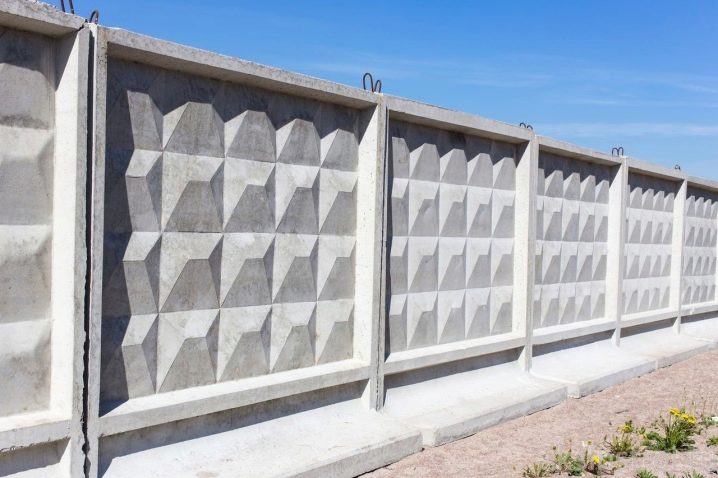
Double Sided Concrete Fence
This sturdy fence has a stylish look both from the street and from the yard, because the decor on the products is applied from both sides. The latest trends in design allow you to choose a chic concrete fence with the stylization of brickwork, natural stone, slate or luxurious wild stone. For the production of plates, the latest equipment, high-quality polyurethane molds are used. They completely repeat the texture of natural materials.


As a result, the length of this slab is 5 m, the height is almost 2.5 m, and the thickness is just over 12 cm. The elements of such a structure are very massive. Their weight is more than 3 tons, and since according to the technology the panel is installed with a pillar, it can even withstand a collision with a truck. The use of special fiber gives the fence excellent soundproofing qualities.
Modular structures with pressed concrete supports
A fairly new type of fence that is gaining popularity. Modules can be used to build fences of various shapes, luxurious in appearance. To create a fence, a standard set is used: a pillar, a basement plate, all kinds of sketch images for sections made of wood, metal, profiled sheet, forging. All this is presented in a wide range of colors. The appearance of the fence can have an original pattern that will match the exterior of any house.
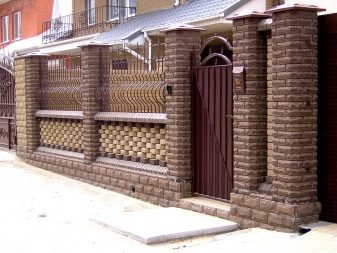
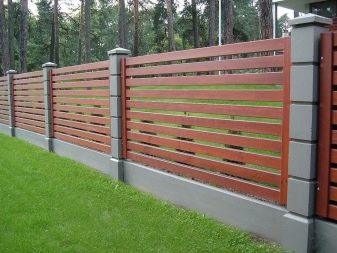
For the construction of fences, foam concrete and aerated concrete are often used.The best option for building a solid fence is gas silicate blocks. The design of them is more durable than foam blocks. It is worth knowing that aerated concrete is more afraid of moisture than its cellular "friend", however, with good waterproofing, this problem can be quickly resolved. As for the long service life, then buying high-quality aerated concrete, there is no doubt about its performance... The cost of purchasing these blocks will be significantly reduced due to their low price. Thanks to the solid size of the blocks, a new fence can be erected in a matter of hours.
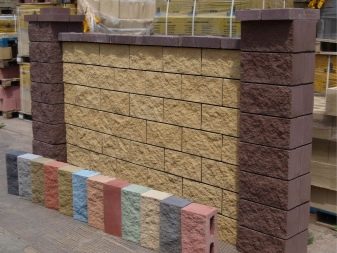

Dimensions (edit)
Typical slab dimensions are 2 m wide and 50 cm high. Taking into account the tolerances and all kinds of gaps, it is customary to take the length of 2.06 m as a basis.The height of the post varies from 0.65 to 2.60 m.The recommended height of the fence will also be 2 m, and the thickness is usually from 4 to 8 cm. parameters, the site will be completely hidden from curious people. When calculating, it is necessary to take into account the pillars of the support, which have a standard section of 15x15 cm.Thus, when installing 10 slabs with a length of 2.06 m, the total length of the fence will be 20.75 m, and this is taking into account the first and last support pillars.
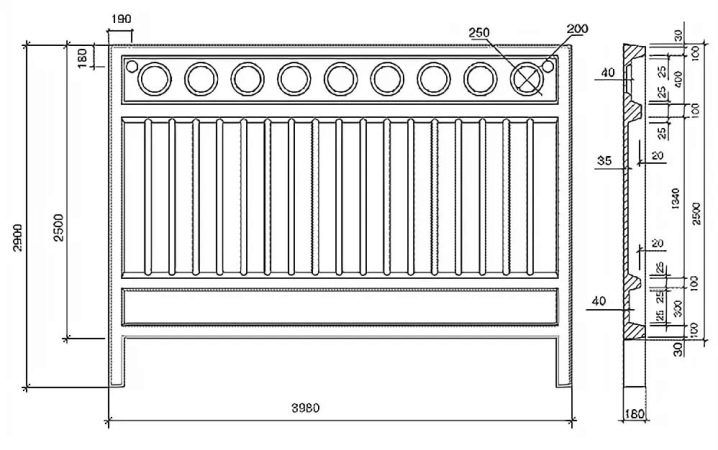
Self-standing fences are made up to 3 m high, and the weight of only one section can reach almost 2.5 tons.
Decor and painting
Most often, concrete fences are designed to match the relief of natural stone. Imitations of branches of various trees, solid masonry of stone and brick, logs or timber are also popular. More complex designs can consist of several types of blocks. They are often indistinguishable from options that are built of natural stone. At the top of the fence, they most often make an imitation of a lattice or balusters. With the right choice of colors and textures of the decor, it is almost impossible to determine what exactly the fence itself was made of.

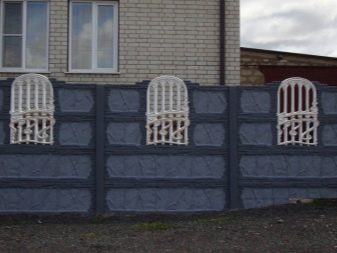
The most original idea of the designers is to decorate the walls with an openwork pattern or an authentic imitation of weaving from a vine or bamboo.
Concrete is an amazing coating. With its help, you can embody any fantasy idea, which is especially important in cases when the usual appearance of the product seems gray and boring. It is not at all necessary that this structure has only a protective role. Many hedges are really colorful pieces. If you have purchased (or made yourself) panels with beautiful projections, reliefs, patterns or weaving, then you just have to take good care of the coatings: clean them in time, tint them if necessary. If your new fence is not painted yet, you can decorate it with your own hands in a matter of hours. Its appearance is determined by the owner of the dwelling.
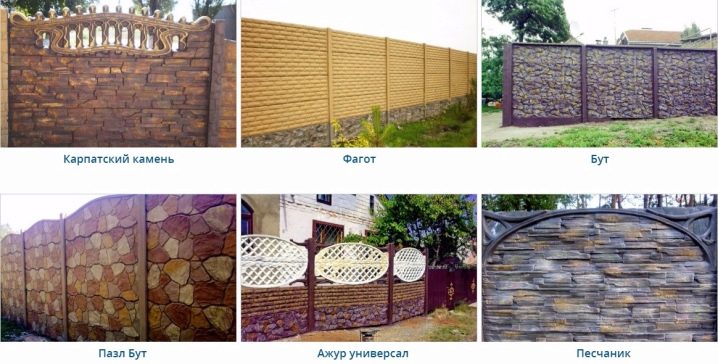
When decorating a structure, you can use options such as:
- staining;
- combination with forged components;
- laying stylish tiles, stone or special panels that imitate different materials;
- use of art exposition, copyright graffiti, drawings with popular cartoon characters;
- imitation of plants such as climbing ivy, rose and many others.
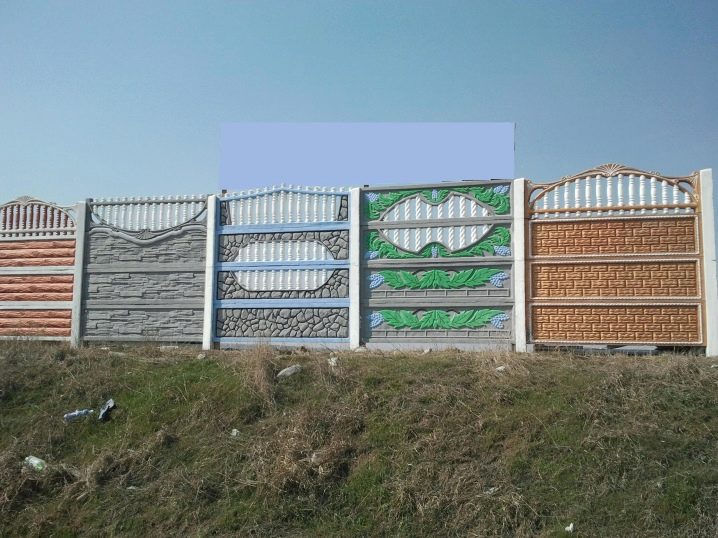
If it is necessary to choose a paint color for the fence, then the most preferable from the point of view of the surrounding space are such colors as green, gray, brown, blue or dark beige. These natural tones will go well with the greenery around the fence. It is not necessary to decorate the fence too brightly and in many colors, it is enough to use a combination of 2-3 shades. Textured elements can be highlighted with white, gray, or any dark color. Using paint, you can beat any concrete surface, giving it the appearance of sandstone or wood.
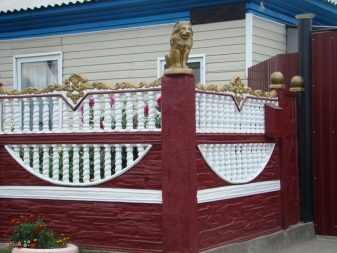
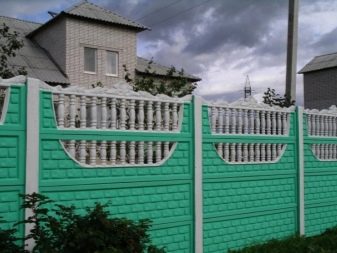
To paint a sandstone fence, you first need to apply a light brown tone, and then use a foam sponge to apply a dark brown tint.
Mounting options
The installation of a concrete structure is usually carried out by 2-3 people, in special cases a truck crane is used.It is possible to qualitatively install even a heavy monolithic fence on its own, but if you take into account the required amount of cement and forces, it can hardly be called inexpensive.
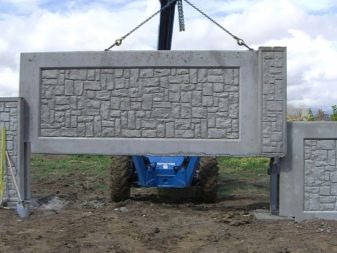
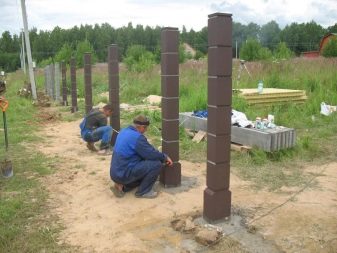
The most convenient installation is considered to be a structure made of concreted sections. This type of fence is often called decorative, eurofence or prefabricated sectional fence. There are many variations on how to mount a sectional fence. This does not require special knowledge (except for the moment of making the supports and the foundation), and even two people can assemble the fence itself. The parameters and weight of the structure allow this: the panels usually weigh from 45 to 70 kg, and the posts - up to 90 kg. A prefabricated product is often made to order, can be assembled from ready-made panels, and can be produced at home. Equipment for making slabs can be purchased at a specialist store.

The installation of concrete fences also means laying the base for the pole support. To do this, you need to prepare a pit 0.5 m deep, and this pit should be 5 cm wider than the pillar block on each side. In the pit, reinforcement is fixed as long as the height of the fence plus its invisible underground part. The reinforcement is fixed at a level, and the pit is immediately concreted. The first of the column sections is fixed to the base, and the free space is also concreted.
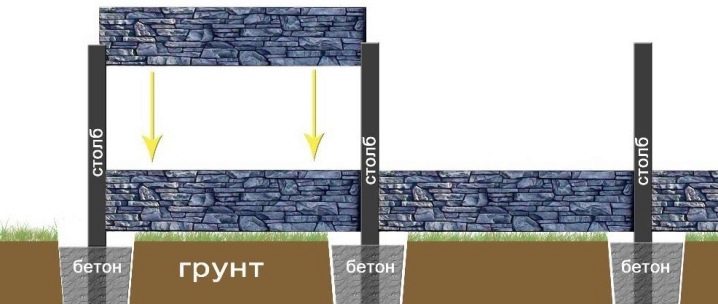
By assembling the next element, you will build a support at the same time with it. It is necessary to concrete all sections of the column separately so that the concrete solution spreads throughout the entire cavity of the support. The second support is assembled in the same way. Further, the installation of the sections is carried out. Installation of additional elements is very simple. It is necessary to carefully install them in the grooves of the already standing supports. It is not necessary to mount more than 2 sections between 2 posts. It is necessary to build the fence gradually in order to eliminate the skewing of the structure. Any defects during installation can be leveled with cement.
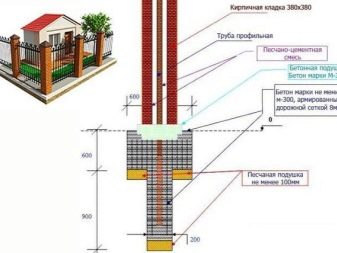
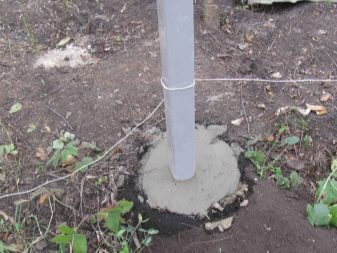
Advice
If you need to choose the grade of concrete for creating monolithic slabs, you need to choose the best quality product. Check if reinforcing parts will be used as part of the future structure, because this plays a role in the choice of concrete. Thus, most often the choice stops at the M250-350 brands. When installing a fence on your own at a private home, it is best to entrust the choice of solution to an experienced specialist. If the fence does not imply a solid foundation, you can choose a lightweight type of concrete that will cost you the least.
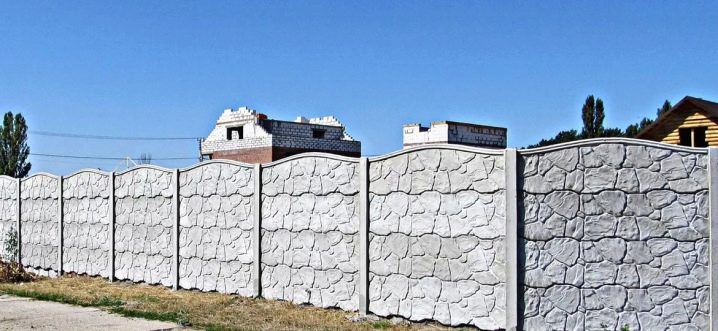
How to install a concrete fence yourself, see below.



































































I like it.
The comment was sent successfully.